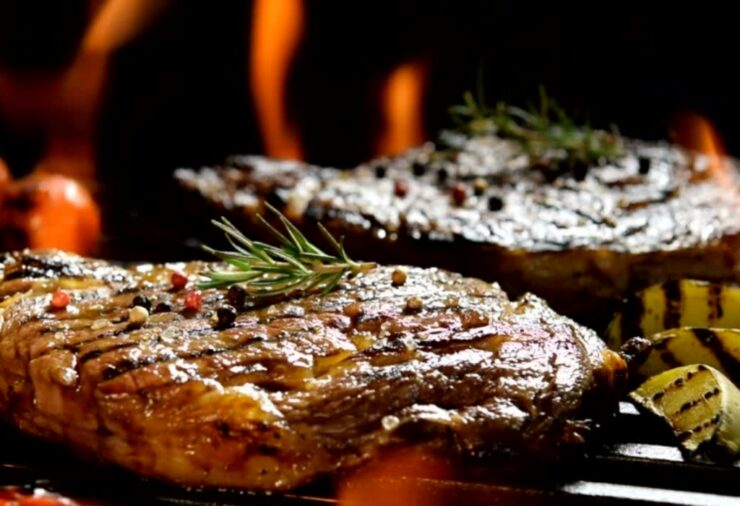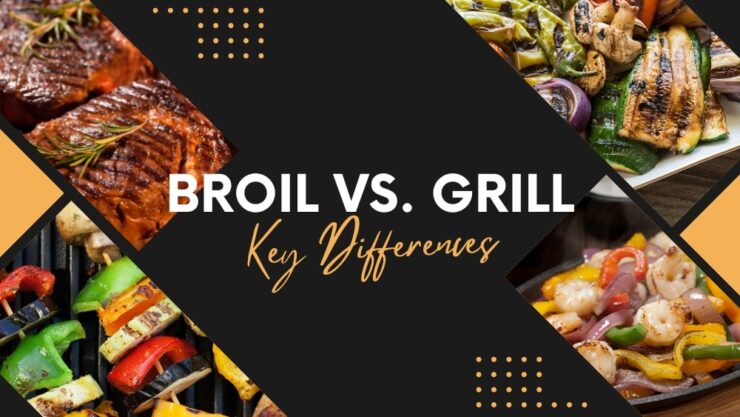Cooking is a multifaceted practice that intertwines art and science, culture and technique. Among the myriad methods employed, broiling and grilling stand as two of the most popular enjoyed globally for the distinct flavors they impart and the communal experience they often engender.
Despite their similarities, they are fundamentally different, and understanding these key differences can significantly enhance your cooking repertoire. This post will delve into the nuances of these methods, aiming to clarify their unique features and equip you with the knowledge to utilize them effectively.
Definition of Broiling
Broiling is a cooking method that involves applying direct, intense heat from above to the food. It’s akin to an inverted grill, with the heat source positioned overhead instead of beneath. While you can broil food with specialized broilers, a typical kitchen oven is usually equipped with a broiler setting or compartment. The broiling process is characterized by its capacity to cook food quickly, create a pleasing char or crust, and achieve a specific level of doneness.
Definition of Grilling

On the contrary, grilling involves a direct heat source situated below the food. The most common piece of equipment used for it is, of course, a grill, which can be powered by gas, charcoal, or even electricity. It is synonymous with the outdoors and summertime, with the sound of sizzling food, the smell of smoke, and the warmth of the grill itself being integral components of the experience. The method imbues food with a distinctive, smoky flavor and aesthetic appeal, thanks to the marks it leaves.
Heating Source
The heat source’s positioning forms the crux of the disparity between them. In broiling, the source of the heat resides above, and food directly receives this top-down heat, much like receiving sunlight at noon.
Grilling, however, employs a reverse, bottom-up methodology. Heat ascends from the base, cooking food as it rises, similar to sitting beside a campfire. This fundamental difference in heat orientation isn’t a trivial matter. It significantly impacts the culinary process, dictating cooking time, influencing how flavors develop, and shaping the texture and visual appeal of the end result. In essence, the heat source’s position determines the character of your dish, making the distinction between broiling and grilling crucial to the cooking journey.
Temperature Control
If we shift our focus to temperature control, another layer of divergence surfaces between them. Broiling operates on high, consistent temperatures. Its lack of flexibility in heat modulation demands constant attention to avert the disaster of burnt or overcooked food.
On the flip side, grilling provides a greater degree of control over the temperature, ensuring a more precise and tailored cooking experience. By simply turning a knob or moving food to less heated grill areas, you can manipulate the heat intensity, showcasing grilling’s adaptability. This control element is a game-changer in the culinary world, underscoring the fundamental differences between them.
Cooking Time and Techniques

When it comes to the cooking time and techniques, broiling and grilling diverge noticeably. Broiling, with its high-intensity heat, cooks food rapidly, making it ideal for thinner cuts of meat, fish, or vegetables that require short cooking durations. On the other hand, grilling often involves longer cooking times, particularly for larger, thicker cuts of meat. This slower cooking process allows the food to absorb more of the smoky flavor distinctive from grilling.
Flavor and Texture
Flavor and texture are perhaps the most enjoyable areas of difference between broiling and grilling. Broiling often results in a well-caramelized crust on the food’s surface, with juices locked in for a succulent finish. Grilling, meanwhile, imparts a smoky flavor and produces attractive char marks, adding to the food’s visual and gustatory appeal. Both methods can produce a range of textures, from crispy to tender, depending on the food item and cooking duration.
Food Types
While you can broil and grill a wide variety of foods, certain items are more suited to one method than the other. For broiling, think of thin cuts of steak, seafood like shrimp and fish, as well as vegetables such as bell peppers and asparagus. Grilling, meanwhile, is ideal for thicker cuts of meat like ribs or whole bird, hearty vegetables like corn and eggplant, and even fruits for a sweet, smoky dessert!
Health Considerations
Health-wise, both broiling and grilling offer benefits such as fat reduction, as excess fat can drip away during the cooking process. However, there are concerns associated with these methods. Charring food on a grill can lead to the formation of potential carcinogens. Similarly, broiling at high temperatures can produce advanced glycation end products (AGEs), compounds linked to inflammation and chronic illness. Moderation, attention to cooking times and temperatures, and a balanced diet can help mitigate these potential risks.
Versatility and Convenience
Broiling scores high in terms of indoor cooking convenience, allowing you to cook without needing an outdoor space. It’s also relatively mess-free and efficient. Grilling, on the other hand, shines in its versatility to impart unique flavors, especially when using different types of wood or charcoal. While it’s predominantly an outdoor activity, tabletop grills have made indoor grilling more accessible.
Tips for Successful Broiling and Grilling
Mastering the art of broiling and grilling requires a grasp of certain key principles and techniques. To help you navigate these cooking methods with confidence, here’s a handy list of tips to ensure your success:
- Preheat your equipment: Whether broiling or grilling, preheating is essential. This prepares your cooking surface, ensuring an even and adequate temperature, which in turn helps food to cook uniformly and develop a desirable sear.
- Use a thermometer: A quality food thermometer is invaluable for achieving perfect results. It allows you to monitor the internal temperature of your food, ensuring it is cooked to your preferred level of doneness without the guesswork.
- Allow meats to rest after cooking: Once cooked, allow your meats to rest for a few minutes before slicing. This resting period allows the juices to redistribute throughout the meat, ensuring a tender and juicy result.
- Keep a watchful eye when broiling: Given the high heat and rapid cooking time, broiling demands careful monitoring. Keep an eye on your food to prevent burning or overcooking.
- Close the lid when grilling: To maintain temperature and enhance the smoky flavors that grilling imparts, keep the grill lid closed as much as possible.
- Marinades, rubs, and brines are your friends: These flavorful additions can greatly enhance your food’s taste and texture. Moreover, they can serve as a protective barrier, helping to prevent food from drying out in the intense heat.
FAQs
Can I grill all types of meat?
Yes, you can grill almost all types of meat. However, thicker cuts like ribs or whole birds are particularly suited for grilling, as the longer cooking time allows them to absorb more smoky flavor.
Why is preheating important in broiling and grilling?
Preheating ensures that your food starts cooking as soon as it hits the grill or broiler, helping to sear the food, lock in juices, and cook the food evenly.
Why should I let the meat rest after broiling or grilling?
Resting allows the juices to redistribute throughout the meat, resulting in a juicier and more flavorful dish.
How can I prevent food from burning while broiling?
Given the high heat and quick cooking time, broiling requires constant monitoring. Lower the oven rack if the food is browning too quickly and always set a timer to avoid overcooking.
What are the benefits of using marinades, rubs, and brines in broiling and grilling?
These ingredients add flavor and can help protect the food from drying out in the intense heat. They also contribute to the browning and caramelization of the food surface, enhancing its taste and appearance.
Can vegetables and fruits be grilled?
Absolutely! Hearty vegetables like corn, bell peppers, and eggplant grill beautifully, and grilling can bring out a new depth of flavor in fruits like peaches, pineapple, and watermelon.
Conclusion
In sum, while broiling and grilling share similarities as direct-heat cooking methods, they are distinct in their heat source positioning, temperature control, cooking times, and resulting flavors and textures. Understanding these differences will not only make you a more versatile cook but also allow you to select the most appropriate method for your meal, ensuring delicious and satisfying results every time. So, whether it’s the smoky allure of the grill or the quick convenience of the broiler that appeals to you, there’s a world of culinary possibilities awaiting your exploration. Happy cooking!

